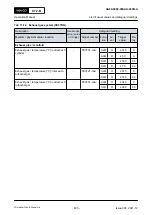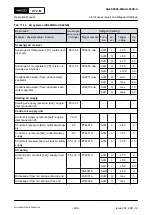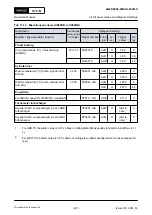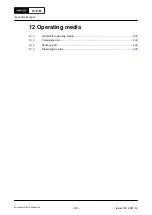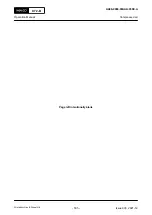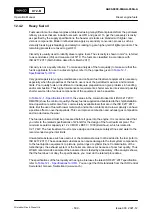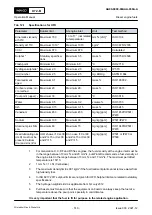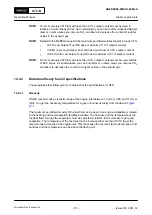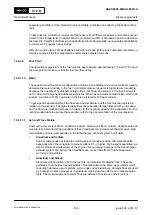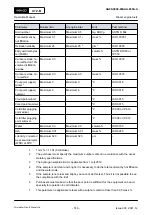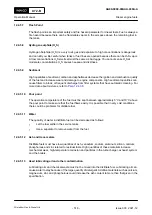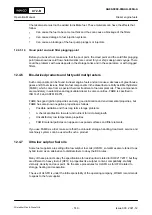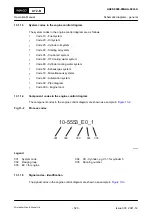
12.4.2
Heavy fuel oil
Fuels used in marine diesel engines are blended using many different products from the petroleum
refinery process that can include fuels such as HFO and gas oil. To get the necessary viscosity
as specified by the supply specifications, the heavier oil stocks are blended with lighter, less
viscous components. Modern refineries also apply a secondary conversion process, such as
viscosity breaking (visbreaking) and catalytic cracking to get a higher yield of lighter products. The
remaining products are mixed to get HFO.
Viscosity is usually used to identify diesel engine fuels. The viscosity is shown in mm
2
/s, referred
to as centistokes (cSt) and measured at 50°C. The fuels are classified in accordance with
ISO 8217:2017 (Sixth Edition dated from March 2017).
Viscosity is not a quality criterion. To make an analysis of the fuel quality (to make sure that the
fuel is applicable for use in a diesel engine), refer to the properties given in
.
Very good supervision, engine maintenance and on board fuel treatment equipment is necessary,
especially when the properties of the fuel in use is near the permitted maximum and minimum
limits. Poor quality fuels or insufficient or inadequate preparation can give problems in handling
and/or combustion. Thus higher maintenance requirements, shorter service intervals and possibly
shorter service life of various components of the equipment can be possible.
In
Table 12-1 - Specifications for HFO
, the values in the column Bunker limit (ISO 8217:2017
RMK700) show the minimum quality of heavy fuel as supplied and bunkered to the ship/installation.
Good operation results come from commercially available fuels that are in the ISO 8217:2017
limits. But the use of fuel with lower metal, ash and carbon contents and a lower density can have
a positive effect on overhaul periods. This can improve combustion and exhaust gas composition
and can decrease the wear.
The fuel as bunkered must be processed before it goes into the engine. It is recommended that
you refer to the related specifications of WinGD for the design of the fuel treatment plant. The
minimum separator capacity is 1.2 x CMCR x BSFC / 1000 (liters/hour), which is related to
0.21 l
⁄
kW. The fuel treatment must remove sludge and decrease catalyst fines and water to the
recommended engine inlet limits.
Unwanted substances such as used oil or chemical waste must not be added to the fuel (refer to
ISO 8217:2017). These unwanted substances can cause damage to the fuel system components,
to the fuel injection equipment, to pistons, piston rings or cylinder liners. Contamination of the
turbocharger, the exhaust system or the boiler can also occur because of poor fuel quality. Thus
WinGD recommends a sample of the bunkered fuel is tested by a laboratory. If the analysis shows,
that the fuel does not obey the specifications, you must do the related procedures.
The specifications of the fuel quality at the engine inlet uses the latest ISO 8217:2017 specification,
refer to
Table 12-1 - Specifications for HFO
. You can get the ISO standards from the ISO Central
Secretariat, Geneva, Switzerland (www.iso.ch).
X72-B
AA00-0000-00AAA-030A-A
Operation Manual
Diesel engine fuels
Winterthur Gas & Diesel Ltd.
- 509 -
Issue 003 2021-12
Содержание X72-B
Страница 8: ...X72 B Operation Manual Page left intentionally blank Winterthur Gas Diesel Ltd 8 Issue 003 2021 12...
Страница 18: ...X72 B Operation Manual Page left intentionally blank Winterthur Gas Diesel Ltd 18 Issue 003 2021 12...
Страница 137: ...X72 B Operation Manual Page left intentionally blank Winterthur Gas Diesel Ltd 137 Issue 003 2021 12...
Страница 301: ...7 Installation 7 1 Installation 302 X72 B Operation Manual Winterthur Gas Diesel Ltd 301 Issue 003 2021 12...

